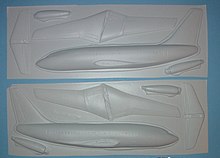Vacuum forming
Relatively deep parts can be formed if the formable sheet is mechanically or pneumatically stretched prior to bringing it into contact with the mold surface and applying the vacuum.
This high impact material is hygienic and capable of retaining heat and its shape when warm water is applied and is commonly used to package taste and odor sensitive products.
[3] Original equipment manufacturers (OEMs) utilize heavy gauge vacuum formed components for production quantities in the range of 250–3000 units per year.
Vacuum-formed components can be used in place of complex fabricated sheet metal, fiberglass, or plastic injection molding.
Typical industry examples besides product packaging include: fascias for outdoor kiosks and automated teller machines, enclosures for medical imaging and diagnostic equipment, engine covers in a truck cab or for construction equipment, and railcar interior trim and seat components.
Wood patterns are a common material to vacuum form as it is relatively inexpensive and allows the customer to make changes to the design easily.
Composite molds are typically made from filled resins that start as a liquid and harden with time.
Depending on the application, composite molds can last a very long time and produce high quality parts.
Once a vacuum forming has been created out of a sheet of plastic, a finishing operation will be needed in most cases to turn it into a usable product.




